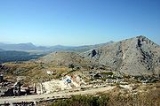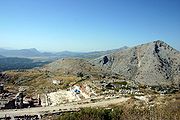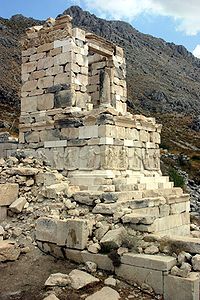
Sagalassos
Encyclopedia

Archaeological site
An archaeological site is a place in which evidence of past activity is preserved , and which has been, or may be, investigated using the discipline of archaeology and represents a part of the archaeological record.Beyond this, the definition and geographical extent of a 'site' can vary widely,...
in southwestern Turkey
Turkey
Turkey , known officially as the Republic of Turkey , is a Eurasian country located in Western Asia and in East Thrace in Southeastern Europe...
, about 100 km north of Antalya
Antalya
Antalya is a city on the Mediterranean coast of southwestern Turkey. With a population 1,001,318 as of 2010. It is the eighth most populous city in Turkey and country's biggest international sea resort.- History :...
(ancient Attaleia), and 30 km from Burdur
Burdur
Burdur , is a city southwestern Turkey and the seat of the Burdur Province of Turkey. It is located at , on the shore of Lake Burdur...
and Isparta
Isparta
Isparta is a city in western Turkey and the provincial capital of the Isparta Province. The city's population is 222,556 and elevation from sea level is 1035 m. Another name of the city is "City of Roses"....
. The ancient ruins of Sagalassos are 7 km from Ağlasun
Aglasun
Ağlasun is a town and district of Burdur Province in the Mediterranean region of Turkey...
in the province of Burdur
Burdur
Burdur , is a city southwestern Turkey and the seat of the Burdur Province of Turkey. It is located at , on the shore of Lake Burdur...
, on Mount Akdağ
Akdag
Akdağ is the name of several different mountains in Turkey.One of them is in the Çameli district of Denizli Province, and in the Çivril district of Afyon Province. It is located at the western end of the Taurus Mountains in Aegean Region of Turkey. Its highest peak is 3,213 m...
, in the Western Toros
Taurus Mountains
Taurus Mountains are a mountain complex in southern Turkey, dividing the Mediterranean coastal region of southern Turkey from the central Anatolian Plateau. The system extends along a curve from Lake Eğirdir in the west to the upper reaches of the Euphrates and Tigris rivers in the east...
mountain range, at an altitude of 1450-1700 metres.
In Roman Imperial
Roman Empire
The Roman Empire was the post-Republican period of the ancient Roman civilization, characterised by an autocratic form of government and large territorial holdings in Europe and around the Mediterranean....
times, the town was known as the 'first city of Pisidia
Pisidia
Pisidia was a region of ancient Asia Minor located north of Lycia, and bordering Caria, Lydia, Phrygia and Pamphylia. It corresponds roughly to the modern-day province of Antalya in Turkey...
', a region in the western Taurus mountains
Taurus Mountains
Taurus Mountains are a mountain complex in southern Turkey, dividing the Mediterranean coastal region of southern Turkey from the central Anatolian Plateau. The system extends along a curve from Lake Eğirdir in the west to the upper reaches of the Euphrates and Tigris rivers in the east...
, currently known as the Turkish Lakes Region. Already during the Hellenistic period, it had been one of the major Pisidia
Pisidia
Pisidia was a region of ancient Asia Minor located north of Lycia, and bordering Caria, Lydia, Phrygia and Pamphylia. It corresponds roughly to the modern-day province of Antalya in Turkey...
n towns.
Introduction
The urban site was laid out on various terraces at an altitude between 1400 and 1600 m. After having suffered from a major earthquake in the early sixth century CE, the town still managed to recover, but a cocktail of epidemics, water shortages, a general lack of security and stability, a failing economy and finally another devastating earthquake around the middle of the seventh century forced the inhabitants to abandon their town and resettle in the valley.Large-scale excavations started in 1990 under the direction of Marc Waelkens
Marc Waelkens
Marc Waelkens is a professor of archaeology at the Katholieke Universiteit Leuven in Belgium. He is director of the excavation at the Pisidian city of Sagalassos in Turkey...
of the Katholieke Universiteit Leuven
Katholieke Universiteit Leuven
The Katholieke Universiteit Leuven is a Dutch-speaking university in Flanders, Belgium.It is located at the centre of the historic town of Leuven, and is a prominent part of the city, home to the university since 1425...
. A large number of buildings, monuments and other archaeological remains have been exposed, documenting the monumental aspect of the Hellenistic, Roman
Ancient Rome
Ancient Rome was a thriving civilization that grew on the Italian Peninsula as early as the 8th century BC. Located along the Mediterranean Sea and centered on the city of Rome, it expanded to one of the largest empires in the ancient world....
and early Byzantine
Byzantine Empire
The Byzantine Empire was the Eastern Roman Empire during the periods of Late Antiquity and the Middle Ages, centred on the capital of Constantinople. Known simply as the Roman Empire or Romania to its inhabitants and neighbours, the Empire was the direct continuation of the Ancient Roman State...
history of this town.
History

Hittites
The Hittites were a Bronze Age people of Anatolia.They established a kingdom centered at Hattusa in north-central Anatolia c. the 18th century BC. The Hittite empire reached its height c...
documents refer to a mountain site of Salawassa in the fourteenth century BCE and the town spread during the Phrygia
Phrygia
In antiquity, Phrygia was a kingdom in the west central part of Anatolia, in what is now modern-day Turkey. The Phrygians initially lived in the southern Balkans; according to Herodotus, under the name of Bryges , changing it to Phruges after their final migration to Anatolia, via the...
n and Lydia
Lydia
Lydia was an Iron Age kingdom of western Asia Minor located generally east of ancient Ionia in the modern Turkish provinces of Manisa and inland İzmir. Its population spoke an Anatolian language known as Lydian....
n cultures. Sagalassos was part of the region of Pisidia
Pisidia
Pisidia was a region of ancient Asia Minor located north of Lycia, and bordering Caria, Lydia, Phrygia and Pamphylia. It corresponds roughly to the modern-day province of Antalya in Turkey...
in the western part of the Taurus Mountains
Taurus Mountains
Taurus Mountains are a mountain complex in southern Turkey, dividing the Mediterranean coastal region of southern Turkey from the central Anatolian Plateau. The system extends along a curve from Lake Eğirdir in the west to the upper reaches of the Euphrates and Tigris rivers in the east...
. During the Persian period, Pisidia became known for its warlike factions.
Sagalassos was one of the wealthiest cities in Pisidia when Alexander the Great conquered it in 333 BCE on his way to Persia. It had a population of a few thousand. After Alexander's death, the region became part of territories of Antigonus Monophthalmus, possibly Lysimachus of Thrace, the Seleucids of Syria
Syria
Syria , officially the Syrian Arab Republic , is a country in Western Asia, bordering Lebanon and the Mediterranean Sea to the West, Turkey to the north, Iraq to the east, Jordan to the south, and Israel to the southwest....
and the Attalids of Pergamon
Pergamon
Pergamon , or Pergamum, was an ancient Greek city in modern-day Turkey, in Mysia, today located from the Aegean Sea on a promontory on the north side of the river Caicus , that became the capital of the Kingdom of Pergamon during the Hellenistic period, under the Attalid dynasty, 281–133 BC...
. Archeological record indicates that locals rapidly adopted Hellenic culture.
The Roman Empire
Roman Empire
The Roman Empire was the post-Republican period of the ancient Roman civilization, characterised by an autocratic form of government and large territorial holdings in Europe and around the Mediterranean....
absorbed Pisidia after the Attalids and it became part of province of Asia. In 39 BCE it was handed out to Galatia
Galatia
Ancient Galatia was an area in the highlands of central Anatolia in modern Turkey. Galatia was named for the immigrant Gauls from Thrace , who settled here and became its ruling caste in the 3rd century BC, following the Gallic invasion of the Balkans in 279 BC. It has been called the "Gallia" of...
n client king Amyntas
Amyntas
-External links:*...
but after he was killed in 25 BCE, Rome turned Pisidia into the province of Galatia. Under the Roman Empire, Sagalassos became the important urban center of Pisidia, particularly favoured by the Emperor Hadrian
Hadrian
Hadrian , was Roman Emperor from 117 to 138. He is best known for building Hadrian's Wall, which marked the northern limit of Roman Britain. In Rome, he re-built the Pantheon and constructed the Temple of Venus and Roma. In addition to being emperor, Hadrian was a humanist and was philhellene in...
, who named it the "first city" of the province and the center of the imperial cult
Imperial cult
An imperial cult is a form of state religion in which an emperor, or a dynasty of emperors , are worshipped as messiahs, demigods or deities. "Cult" here is used to mean "worship", not in the modern pejorative sense...
. Contemporary buildings have a fully Roman character.
Around 400 CE Sagalassos was fortified for defence. An earthquake
Earthquake
An earthquake is the result of a sudden release of energy in the Earth's crust that creates seismic waves. The seismicity, seismism or seismic activity of an area refers to the frequency, type and size of earthquakes experienced over a period of time...
devastated it in 518 and a plague circa 541-543 halved the local population. Arab raids threatened the town around 640 and after another earthquake destroyed the town in the middle of the seventh century, the site was abandoned. The populace probably resettled in the valley. Excavations have found only signs of a fortified monastery -- possibly a religious community, which was destroyed in the twelfth century. Sagalassos disappeared from the records.
In the following centuries, erosion covered the ruins of Sagalassos. It was not looted in significant extent, possibly because of its location.
Explorer Paul Lucas
Paul Lucas (traveller)
Paul Lucas was a French merchant, naturalist, physician and antiquarian to King Louis XIV. He travelled extensively in Greece, Turkey, the Levant and Egypt, in three major voyages , and ....
, who was traveling in Turkey
Turkey
Turkey , known officially as the Republic of Turkey , is a Eurasian country located in Western Asia and in East Thrace in Southeastern Europe...
on a mission for the court of Louis XIV of France
Louis XIV of France
Louis XIV , known as Louis the Great or the Sun King , was a Bourbon monarch who ruled as King of France and Navarre. His reign, from 1643 to his death in 1715, began at the age of four and lasted seventy-two years, three months, and eighteen days...
, visited the ruins in 1706. After 1824, when Francis Vyvyan Jago Arundell
Francis Vyvyan Jago Arundell
-Biography:Arundell was born at Launceston, Cornwall in July 1780, being the only son of Thomas Jago, a solicitor in that town, who married Catherine, a daughter of Mr. Bolt, a surgeon at Launceston. Francis was educated at Liskeard Grammar School and at Exeter College, Oxford, where he took the...
(1780 - 1846), the British chaplain at Izmir and an antiquary, visited the site and deciphered its name in inscriptions, Western travelers begun to visit the ruins. Polish historian of art, count K. Lanckoronski produced the first map of Sagalassos. However, the city did not attract much archaeological attention until 1985, when a British-Belgian team led by Stephen Mitchell begun a major survey of the site.
Modern project

Marc Waelkens
Marc Waelkens is a professor of archaeology at the Katholieke Universiteit Leuven in Belgium. He is director of the excavation at the Pisidian city of Sagalassos in Turkey...
of the Catholic University of Leuven
Catholic University of Leuven
The Catholic University of Leuven, or of Louvain, was the largest, oldest and most prominent university in Belgium. The university was founded in 1425 as the University of Leuven by John IV, Duke of Brabant and approved by a Papal bull by Pope Martin V.During France's occupation of Belgium in the...
in Belgium
Belgium
Belgium , officially the Kingdom of Belgium, is a federal state in Western Europe. It is a founding member of the European Union and hosts the EU's headquarters, and those of several other major international organisations such as NATO.Belgium is also a member of, or affiliated to, many...
. The monumental city center is now exposed; four major restoration projects are (nearly) completed. The project also undertakes an intensive urban and geophysical survey, excavations in the domestic and industrial areas, and an intensive survey of the territory. The first survey documents a thousand years of occupation -- from Alexander the Great to the seventh century -- while the latter has established the changing settlement patterns, the vegetation history and farming practices, the landscape formation and climatic changes during the last 10,000 years.
On August 9, 2007, the press reported the discovery of a finely detailed, colossal statue
Statue
A statue is a sculpture in the round representing a person or persons, an animal, an idea or an event, normally full-length, as opposed to a bust, and at least close to life-size, or larger...
of the Emperor Hadrian
Hadrian
Hadrian , was Roman Emperor from 117 to 138. He is best known for building Hadrian's Wall, which marked the northern limit of Roman Britain. In Rome, he re-built the Pantheon and constructed the Temple of Venus and Roma. In addition to being emperor, Hadrian was a humanist and was philhellene in...
, which is thought to have stood 4-5m in height. The statue dates to the early part of Hadrian's reign, and depicts the emperor in military garb. It was carved in sections that were fitted together with marble tenons on the site, which was a thermae
Thermae
In ancient Rome, thermae and balnea were facilities for bathing...
, a public bath. A major earthquake sometime between the late sixth and early seventh centuries CE brought the vaulting crashing down; the statue of Hadrian was felled, coming apart along the joins of its facture. The discovery of carved marble toes drilled with dowel holes to fasten them to the hem of a long mantle suggests the possibility of finding a companion sculpture of Sabina
Vibia Sabina
Vibia Sabina was a Roman Empress, wife and second cousin, once removed, to Roman Emperor Hadrian. She was the daughter to Salonina Matidia , and suffect consul Lucius Vibius Sabinus...
, the emperor's consort. On August 14, 2008, the head statue of Faustina the Elder
Faustina the Elder
Annia Galeria Faustina, more familiarly referred to as Faustina I , was a Roman Empress and wife of Roman Emperor Antoninus Pius.-Early life:...
, wife of Roman emperor Antoninus Pius
Antoninus Pius
Antoninus Pius , also known as Antoninus, was Roman Emperor from 138 to 161. He was a member of the Nerva-Antonine dynasty and the Aurelii. He did not possess the sobriquet "Pius" until after his accession to the throne...
(Hadrian's successor and adopted son) was discovered in the same site. On August 22, 2008, another colossal portrait head was found, this time of Marcus Aurelius.
In a phylogenetic study the mitochondrial DNA of 85 skeletons from Sagalassos dated to the 11th–13th century AD was compared to modern populations. The research found a significant maternal genetic signature of Balkan/Greek populations, as well as ancient Persians and populations from the Italian peninsula. Some contribution from the Levant was also detected, whereas no contribution from Central Asian population was ascertained.
Getting There
For information on how to get to Ağlasun and Sagalassos, click here.External links
- Huge statue of Roman ruler found
- Website Sagalassos Archaeological Research Project
- Sagalassos Interactive Dig
- Beyaz Arif Akbas: Sagalassos: City of Fairies", Adrianapolis, Yalnizgoz Yay. 2010, ISBN 978-1-4536-1300-9. http://en.calameo.com/read/0002983841c7acaa28dc8

